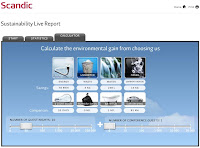On the 8th day after Copenhagen, the obvious whacked me upside the head...
In recent weeks, I've observed several events that support the theory that China wants to be economically and geopolitically dominant in the coming Low Carbon Economy.
First, China does not want Copenhagen to establish a flat playing field in the low carbon economy and got everything it wanted at the summit; no binding agreement, no targets, no timetable and contention and disarray within the global community.
Second, while spot prices for coal in China have risen steadily during 2009 due to increasing demand, the government has curtailed coal production and now sits on a historically low 12-day supply. It has mandated over 1500 coal mines under 300,000 tons/year output will be closed by the end of 2010. This constrained supply will drive coal and coke prices up further raising the cost of fossil fuel-based energy across their entire manufacturing sector.
Third, on December 28th, the Chinese government revised its renewable energy laws to mandate that utilities buy 100% of the renewable energy produced and established severe financial penalties for non-compliance. This action will dramatically raise the cost of coal-based energy and incentivize investment in renewables by guaranteeing a market for renewable energy at any/all future production levels.
Further investigation reveals other actions taken by China in 2009:
In recent weeks, I've observed several events that support the theory that China wants to be economically and geopolitically dominant in the coming Low Carbon Economy.
First, China does not want Copenhagen to establish a flat playing field in the low carbon economy and got everything it wanted at the summit; no binding agreement, no targets, no timetable and contention and disarray within the global community.
Second, while spot prices for coal in China have risen steadily during 2009 due to increasing demand, the government has curtailed coal production and now sits on a historically low 12-day supply. It has mandated over 1500 coal mines under 300,000 tons/year output will be closed by the end of 2010. This constrained supply will drive coal and coke prices up further raising the cost of fossil fuel-based energy across their entire manufacturing sector.
Third, on December 28th, the Chinese government revised its renewable energy laws to mandate that utilities buy 100% of the renewable energy produced and established severe financial penalties for non-compliance. This action will dramatically raise the cost of coal-based energy and incentivize investment in renewables by guaranteeing a market for renewable energy at any/all future production levels.
Further investigation reveals other actions taken by China in 2009:
- 54 Gigawatts of China’s smallest, most inefficient coal-fired electrical plants were taken offline in 2009. Replaced with new plants, such as the 1 GW Huaneng Power International coal plant in Yuhuan that can generate a kWh with just 283 grams of coal, a 25% improvement on the their industry average efficiency.
- The central Asian gas pipeline began operations in December. The pipeline will bring 40 billion-cubic-meters/year of natural gas from Turkmenistan, (through Uzbekistan and Kazakhstan) to northwest region of Xinjiang Uyghur Autonomous Region and from there to Shanghai, Guangzhou and Hong Kong.
- In a move to augment its controversial hydro projects, China’s National Energy Administration (NEA) announced it would bring its total wind power capacity to 100 GW by 2020 from the current 12 GW and has planned six 10GW-level wind power bases Inner Mongolia, Gansu, Xinjiang, Hebei and Jiangsu. The first o be built in the Jiuquan will be completed by 2010.
- Construction started in September on three third-generation, pressurized water reactor, nuclear power projects in Sanmen (Zhejiang), Haiyang (Shandong) and Taishan (Guangdong). The fleet will employ AP1000 technology from Westinghouse. The combined capacity will be almost 4GW with the first plant being on-line in 2012. At the same time, the government also revised its plans for nuclear power production capacity in 2020 from 40GW to 70GW.
- Effective January 1, 2010, China will move to a market price-based scheme for oil pricing. In addition, taxes on gasoline will be raised 500% while taxes on diesel fuels will be raised 800%. These incrwases will accelerate the move to electrification of the automobile fleet.
Was China a climate spoiler in Copenhagen or a keen strategist? Are these actions the coordinated effort of a nation that is serious about climate change? Or, does it believe the low carbon economy is coming and an opportuntity to establish itself as the economic and geopolitical leader in the coming era?













